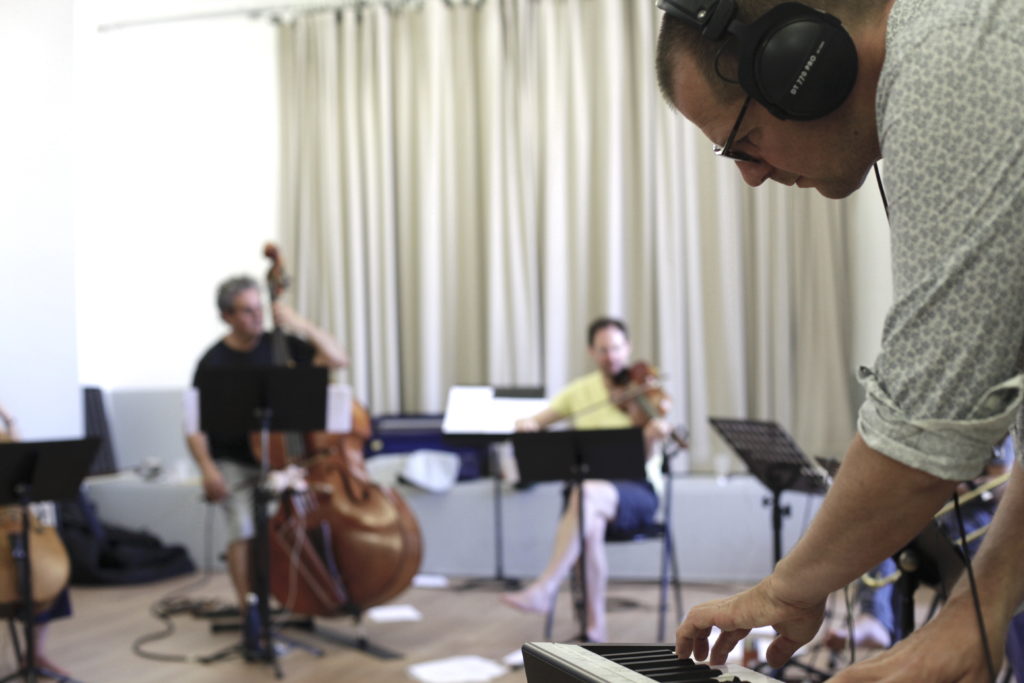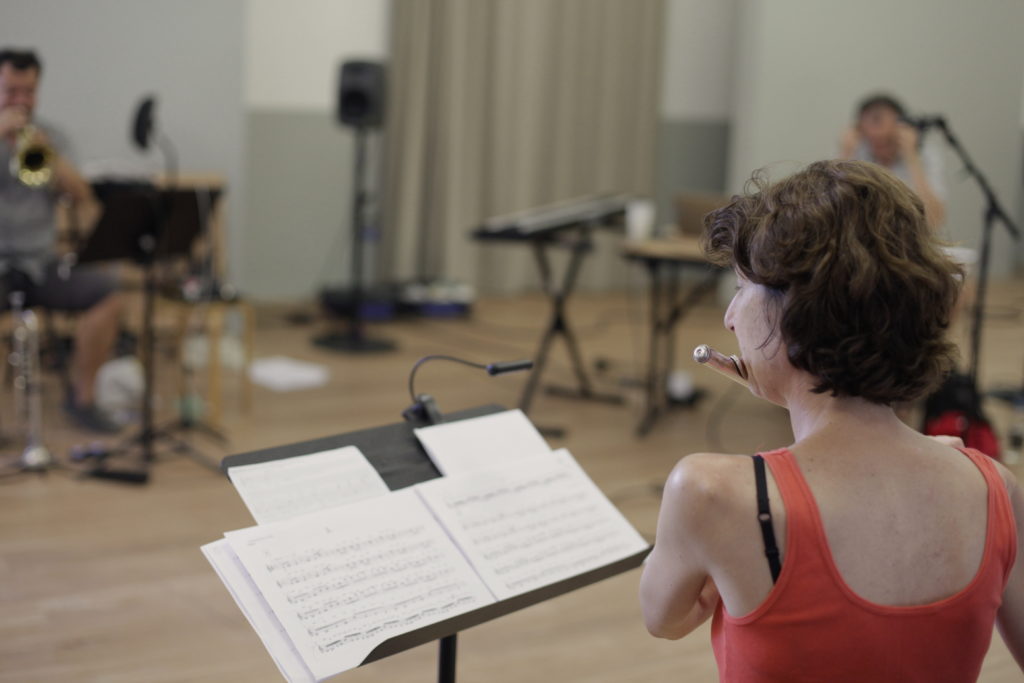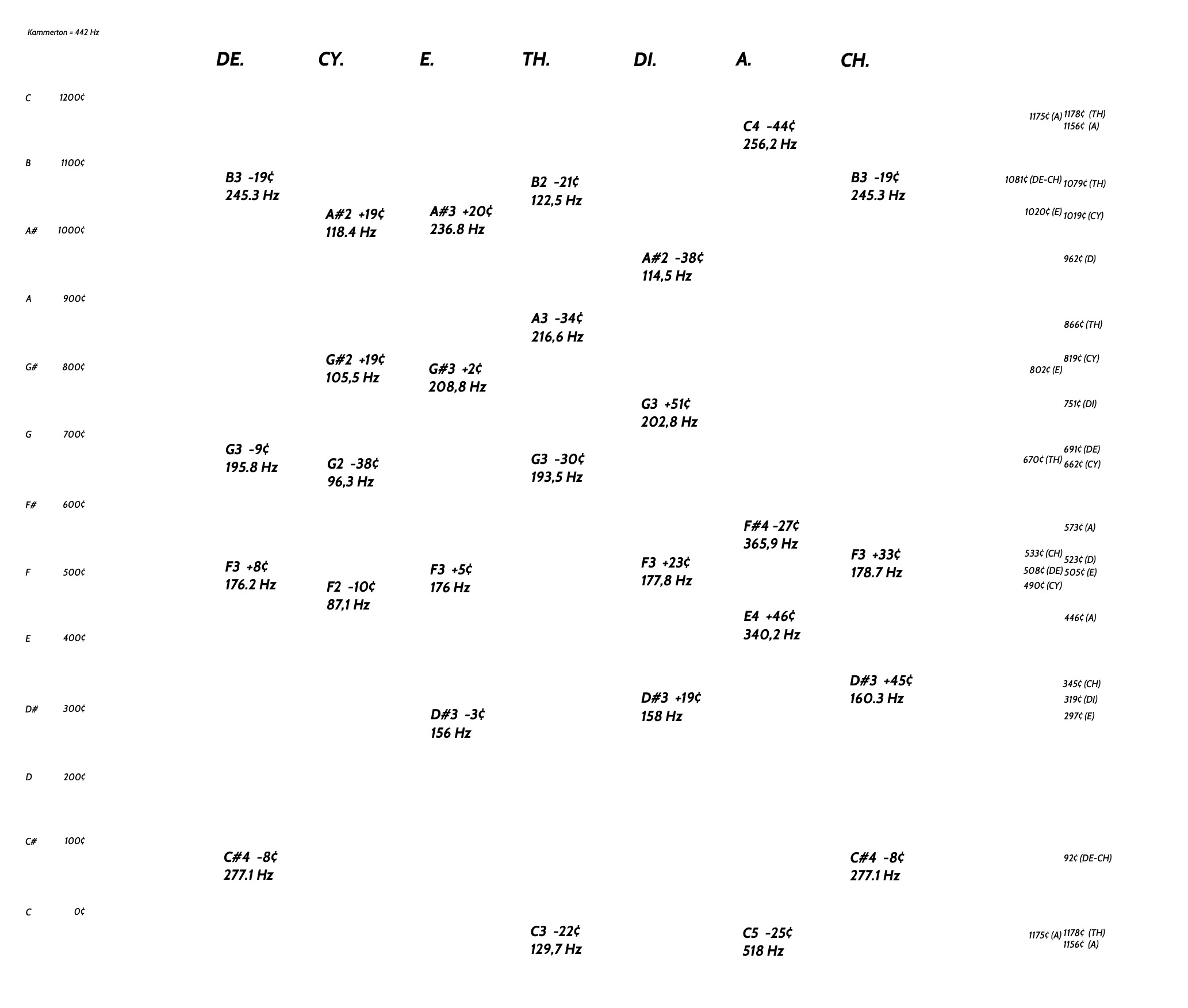Histoire sentimentale des intervalles ( Sentimental History of Intervals )
Harmonic divination in 28 pitches ( for ensembles Dedalus)
Composition
2024
Catalogue number : 97
Questioning seven musicians from the Dedalus ensemble about their relationship with intervals, Alessandro Bosetti asks each of them to sing four notes. On the ensuing harmonic chart, he composes a “Sentimental History of Intervals” for seven instruments, which explores a geography of musical pitches through microtonal writing and meticulous tuning work. The piece is built around the relationships between subjectivity, memory and harmony through free or synaesthetic associations. It traces the emotional stratifications, memories and idiosyncrasies that constitute the collective ear and musical sensitivity of a musical ensemble.
A concert piece which brings into play rational and irrational harmonic relationships, it immerses us in a dreamlike and subjective universe which gives listeners time to familiarize themselves with singular sounds and to linger on the threshold between consonance and dissonance. In particular, it investigates the received idea according to which harmony and different intervals are the component of music which is closest to emotions, memories and unconscious associations.
Think and then sing the first four notes coming to mind.
Let me record them.
Let your memory and intuition be the tuning fork.
Do not make additional attempts.
Just four notes.
Then stop.

Harmonic divination
Alessandro Bosetti appreciates the divinatory aspect of certain sudden and unexpected gestures: saying the first thing that comes to mind, throwing a dice, picking a card from a pack, looking at a handful of objects thrown on a table or scrutinizing sentences picked up by chance in the hubbub of a market (a practice that the ancient Romans called cledomancy).
In this case he employs a form of harmonic divination where one relies on a handful of pitches issued seemingly at random — without preparation or prior agreement. He then takes them extremely seriously, as the cornerstones of an harmonic construction prefiguring an instantaneous musical cosmogony.
After traveling in order to meet all members of the ensemble individually (in Paris, Berlin, Connaux) and to ask them to sing the first four notes that came to their mind (or to their ear), Alessandro Bosetti draws an harmonic chart of the Dedalus ensemble, based on these notes, transcribed with precision, without temperament or transposition. It is a map which he uses as a harmonic palimpsest for a concert instrumental piece. Once drawn on paper – similarly to an astral chart – this map of pitches reveals the collective ear of a group and brings out the composite portrait of the small community of people constituting it.
The piece focuses on the relationships, correspondences and possible trajectories between the notes proposed by each of the musicians during this first divination exercise. Particular attention is paid to the intervals aligning with the grid of just intonation ratios as well as to the other surfacing irrational and dissonant intervals – sonorous objets trouvés, resulting from chance and contingency – and to their relationships and frictions. Which notes are in tune ? What just intoned intervals are to be found between the notes sung by different people? How many variations of a same note within a few cents are there ? And again, which notes are absent ? (curiously, in this case, everyone keeps a distance from the note D).
If we apply Henri Bergson’s famous distinction between « habit memory » and « pure memory » to musicians and to the memorization of intervals, it seems self-evident that the first prevails in the experience of those who have been accustomed all their lives to remembering intervals and reproducing them without hesitation. However, the interval, in particular the harmonic interval, seems to be the most powerful mnemonic and emotional receptacle – at least for Alessandro Bosetti, by his own admission – and each instrumentalist preserves, in the folds of habit, a series of “pure memories” associated to it.
Friction
The work aims to explore the friction that occurs between “just” harmonic materials – i.e. based on simple mathematical ratios – and other “found tunings”, objets trouvés that are mathematically irrational but anchored in memory and immediate sensation.
The piece implements a search for these pitches and intervals that the musicians of the ensemble may have “in themselves”, as if there were a complex force field inherent to the collective body and to the shared memory of the group.
The research was carried out through multiple meetings. What emerges from these meetings is on one hand the individual tetrachord proposed without preparation (and without tuning) by each one of the musicians and, on the other hand, a series of personal reminiscences about the personal mnemonic heritage linked to intervals. Such reminiscences constitute a “Sentimental history of the intervals” whereas the harmonic relationships within the ensemble draw an associative and irrational cartography of this mnemonic and emotional universe which is common to the musicians without them having ever revealed it to each other.
Collective musical biography
In a second phase of the process – not necessarily appearing in the concert but which remains accessible as a documentation – a recollection of personal narratives and a sound archive is carved out from a corpus of recorded testimonies in which each of the performers is asked about his emotional and biographical relationship with particular musical intervals is recomposed into a recorded sound piece.
Each evoked interval — proceeding from unison to octave — is used as points of articulation between the different stories. The composer creates a collective musical biography of the ensemble, in which personal stories, reflections on music and instrumental illustration are fluidly linked.
While the recording of the four pitches used in the harmonic chart took a very short time for each of the performers, this investigation into the personal relationship to musical intervals gave rise to long associative conversations, nourished by biographical details and unexpected revelations. These two components of the work are two facets of the same process and can be presented to the public at contiguous or separate times.
From the interviews conducted for this project emerges a series of fragmented stories, which Alessandro Bosetti prefers to articulate as a single and composite collective biography. It takes the form of a radio montage, structured and driven by the presence and recurrence of certain intervals in the multiple stories. It is about music, in the most diverse forms, but also about personal memories, love, travel, education and study, food and the spaces in which certain musical experiences were first experienced. Sometimes is is about dreams or desires. Occasionally friendships connecting different individuals become visible in certain intersections between narratives.
About intervals
«Music is an occult exercise in arithmetic, in which the mind is not aware that it is calculating.» G. W. Leibniz
The smallest particle of music that Alessandro Bosetti likes to focus on is the interval, that is to say the proportion or difference between the frequencies of two notes. This difference, being a ratio between two quantities, can be expressed in more or less rational fractions (ratios). Surprisingly, it is the relationships between notes, rather than the notes themselves, that have a color, a character or a personality that touches the emotions and activates memory.
Intervals are present in music alone or in complex configurations. We find them superimposed, in succession, stacked into chords or aggregated in “harmonic regions”. When eating a dish composed of several ingredients — although the overall perception is something new and exceeding the sum of the parts — the individual tastes of each ingredient remain simultaneously present to our palate.
Likewise, when listening to a complex chord containing several intervals, each of these intervals – although merging into a global entity – remains independently present to the ear.
Stemming from the idea that there could be fixed associations between intervals and emotions, different conventions have been established depending on the era. Prior to these conventions, however, there must be a region of memory where each person is free to creat deeply personal and arbitrary associations between affects and intervals.
In this composition, Alessandro Bosetti attempts to trace the origin and the intersecting force fields produced by such associations emerging from the personal experiences of the performers of the Dedalus ensemble. The compelling desire that dominates his musical creation – an almost desperate one in the awareness of its impossibility – has always been that of telling a personal story. Yet, despite constant efforts, this story only emerges in tiny fragments and clues, filtering through the abstract nature of the musical material. This composition is no exception and, using intervals as a catalyst or a divinatory tool, it brings together a collective heritage of fragments, memories, idiosyncrasies and emotional associations specific to the handful of individuals — linked together — who make up the Dedalus ensemble.
With and for the ensemble Dedalus:
Didier Aschour, guitar / Amélie Berson, flute / Cyprien Busolini,
viola / Éric Chalan, double bass / Thierry Madiot, bass trombone /
Christian Pruvost, trumpet / Deborah Walker, cello.
Duration: 50’
Production Ensemble Dedalus, GMEA-cncm.
With the support of GMEM-cncm and aide à l’écriture for an original musical work from DRAC Occitanie.
